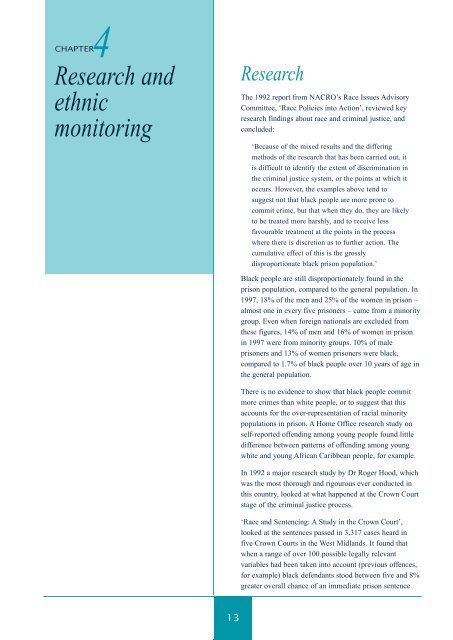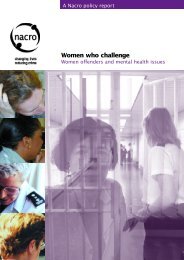structures for youth <strong>justice</strong> are crucial areas in which AreaComm<strong>it</strong>tees can play a strong coordinating role. Similarly,the Council <strong>and</strong> ACJLCs can give a lead on implementingthe Human Rights Act at local level.Race issues must become embedded in the routineagendas of Area Comm<strong>it</strong>tees, so that the implications areconsidered, whatever the topic under discussion. Thediscussions at senior levels on ACJLCs must be turnedinto action at local <strong>and</strong> police divisional areas.Area Comm<strong>it</strong>tees are not well known in theircommun<strong>it</strong>ies. They need to adopt a higher profile, <strong>and</strong>take a lead in providing information about the localcriminal <strong>justice</strong> system, how <strong>it</strong> works, how to complain,how <strong>it</strong> is accountable to the commun<strong>it</strong>y. The WestMidl<strong>and</strong>s ACJLC, for example, has published a statementof comm<strong>it</strong>ments to <strong>race</strong> equal<strong>it</strong>y from each agency. OtherACJLCs are to publish reports based on the NACROaud<strong>it</strong>s of their work on <strong>race</strong> issues.At present, Area Comm<strong>it</strong>tees have no access to resources oftheir own. This needs to be resolved, e<strong>it</strong>her by memberagencies pooling funds or seconding staff, or by setting abud<strong>get</strong> at national level. Some resources are needed so thatACJLCs can undertake pieces of work such as inter-agencytraining, user surveys, or local research or a public event.Race Relations ForumIn May 1998, the Home Secretary announced a new 28member Race Relations Forum to give people fromminor<strong>it</strong>y commun<strong>it</strong>ies a new channel of communication togovernment. It is chaired by the Home Secretary, JackStraw, who said:‘In this country we enjoy many benef<strong>it</strong>s that lifein a multi-cultural society has brought. Much hasbeen achieved. But society is constantlydeveloping <strong>and</strong> <strong>it</strong> is v<strong>it</strong>al that we respond tochanges.’Ensuring a fair <strong>and</strong> non-discriminatory system of <strong>justice</strong>will, <strong>it</strong> is hoped, be a prior<strong>it</strong>y for the Forum.Aims <strong>and</strong> objectives ofthe criminal <strong>justice</strong> systemIn December 1998, the Home Secretary, the LordChancellor <strong>and</strong> the Attorney General issued a publicstatement setting out for the first time joint aims <strong>and</strong>objectives for the criminal <strong>justice</strong> system. These include astrong comm<strong>it</strong>ment to fairness <strong>and</strong> <strong>justice</strong>; one of the twooverarching aims is:‘… to dispense <strong>justice</strong> fairly <strong>and</strong> efficiently <strong>and</strong> topromote confidence in the rule of law’. (‘StrategicPlan for the Criminal Justice System’)Eight objectives support these aims, three of which areparticularly relevant to this report:nnnto meet the needs of victims, w<strong>it</strong>nesses <strong>and</strong> jurorsw<strong>it</strong>hin the system;to respect the <strong>right</strong>s of defendants <strong>and</strong> to treat themfairly; <strong>and</strong>to promote confidence in the criminal <strong>justice</strong> system.To<strong>get</strong>her w<strong>it</strong>h the Human Rights Act, this provides astrong conceptual basis for a fresh approach to achievethe Home Secretary’s aim:‘Fairness of treatment must be <strong>right</strong> at the heart ofany criminal <strong>justice</strong> system.’ACTION POINTSnnnnCriminal Justice Consultative Council must give a new lead to Area Criminal Justice LiaisonComm<strong>it</strong>tees on work on <strong>race</strong>.Crime <strong>and</strong> Disorder Act, Stephen Lawrence Inquiry Report <strong>and</strong> Human Rights Act must setagenda for Area Comm<strong>it</strong>tees.Area Comm<strong>it</strong>tees must raise their profiles in local commun<strong>it</strong>ies <strong>and</strong> ensure channels ofcommunication are open.Home Office <strong>and</strong> Lord Chancellor’s Department must provide more resources to enable ACJLCSto be more proactive at local level.12
CHAPTER4Research <strong>and</strong>ethnicmon<strong>it</strong>oringResearchThe 1992 report from NACRO’s Race Issues AdvisoryComm<strong>it</strong>tee, ‘Race Policies into Action’, reviewed keyresearch findings about <strong>race</strong> <strong>and</strong> criminal <strong>justice</strong>, <strong>and</strong>concluded:‘Because of the mixed results <strong>and</strong> the differingmethods of the research that has been carried out, <strong>it</strong>is difficult to identify the extent of discrimination inthe criminal <strong>justice</strong> system, or the points at which <strong>it</strong>occurs. However, the examples above tend tosuggest not that black people are more prone tocomm<strong>it</strong> crime, but that when they do, they are likelyto be treated more harshly, <strong>and</strong> to receive lessfavourable treatment at the points in the processwhere there is discretion as to further action. Thecumulative effect of this is the grosslydisproportionate black prison population.’Black people are still disproportionately found in theprison population, compared to the general population. In1997, 18% of the men <strong>and</strong> 25% of the women in prison –almost one in every five prisoners – came from a minor<strong>it</strong>ygroup. Even when foreign nationals are excluded fromthese figures, 14% of men <strong>and</strong> 16% of women in prisonin 1997 were from minor<strong>it</strong>y groups. 10% of maleprisoners <strong>and</strong> 13% of women prisoners were black,compared to 1.7% of black people over 10 years of age inthe general population.There is no evidence to show that black people comm<strong>it</strong>more crimes than wh<strong>it</strong>e people, or to suggest that thisaccounts for the over-representation of racial minor<strong>it</strong>ypopulations in prison. A Home Office research study onself-reported offending among young people found l<strong>it</strong>tledifference between patterns of offending among youngwh<strong>it</strong>e <strong>and</strong> young African Caribbean people, for example.In 1992 a major research study by Dr Roger Hood, whichwas the most thorough <strong>and</strong> rigourous ever conducted inthis country, looked at what happened at the Crown Courtstage of the criminal <strong>justice</strong> process.‘Race <strong>and</strong> Sentencing: A Study in the Crown Court’,looked at the sentences passed in 3,317 cases heard infive Crown Courts in the West Midl<strong>and</strong>s. It found thatwhen a range of over 100 possible legally relevantvariables had been taken into account (previous offences,for example) black defendants stood between five <strong>and</strong> 8%greater overall chance of an immediate prison sentence13

















